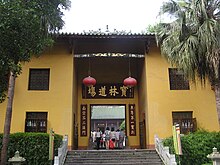Huineng
 | |
| Biografía | |
|---|---|
| Nacemento | 638 Xinxing, República Popular da China (pt) |
| Morte | 713 Shaoguan, República Popular da China (pt) |
| Relixión | Budismo |
| Actividade | |
| Campo de traballo | Filosofía |
| Ocupación | filósofo, poeta, escritor |
| Profesores | Hongren (pt) |
| Familia | |
| Familia | Lu clan of Fanyang (en) |
| Descrito pola fonte | Obálky knih, |
Dajian Huineng (chinés tradicional: 大鑒惠能; chinés simplificado: 大鉴惠能; pinyin: Dàjiàn Huìnéng; Wade-Giles: Ta4-chien4 Hui4-neng2; xaponés: Daikan Enō 大鑒慧能; coreano: Hyeneung 혜능; vietnamita: Huệ Năng), nado no condado de Xinxing (Guangdong) en 638 e finado en 713, tamén coñecido como o Sexto Patriarca ou o Sexto Devanceiro de Chan, é unha figura central semilendaria na primeira época do budismo Chan. Segundo a tradición foi un leigo sen educación que obtivo o espertar de súpeto tras ouvir o sutra do diamante. A pesar da súa falta de adestramento formal, demostrou o seu entendemento ao quinto patriarca, Daman Hongren, que entón escolleu supostamente a Huineng como o seu auténtico sucesor en lugar da escolla coñecida publicamente de Yuquan Shenxiu.
Os estudos do século XX revelaron que a historia da carreira budista de Huineng fora probablemente inventada polo monxe Heze Shenhui, que afirmaba que era un dos discípulos de Huineng e foi enormemente crítico coas ensinanzas de Shenxiu.[1][2][3]
Huineng está considerado o fundador da escola Chan Meridional da "Iluminación Repentina", que se centra nunha obtención inmediata e directa da iluminación budista. A Platforma Sutra do Sexto Patriarca (en chinés: 六祖壇經), que se di que é un rexistro das súas ensinanzas, é un texto de grande influencia na tradición budista da Asia Oriental.
Momificación
[editar | editar a fonte]
Consérvase un corpo momificado, supostamente de Huineng, no templo Nanhua de Shaoguan (norte de Guangdong).[4] A momia foi vista polo xesuíta Matteo Ricci que visitou o templo en 1589. Ricci contou aos lectores europeos a historia de Huineng (nunha forma editada), describíndoo como semellante a un asceta cristián. Ricci chamouno Liùzǔ (i.e. 六祖, "The Sixth Ancestor").[5]
Notas
[editar | editar a fonte]- ↑ McRae 2003.
- ↑ Jorgesen 2005.
- ↑ Schlütter & Teiser 2012.
- ↑ "Images of Huineng's temple and Mummy". Arquivado dende o orixinal o 12-10-2004. Consultado o 16-07-2020.
- ↑ De Christiana expeditione apud Sinas, Book Three, Chapter 1. Pages 222-224 in the English translation: Louis J. Gallagher (1953). "China in the Sixteenth Century: The Journals of Matthew Ricci", Random House, Nova York, 1953.Latin original text: De Christiana expeditione apud Sinas suscepta ab Societate Jesu
Véxase tamén
[editar | editar a fonte]| Wikimedia Commons ten máis contidos multimedia na categoría: Huineng |
| A Galipedia ten un portal sobre: China |
Bibliografía
[editar | editar a fonte]- Addiss, Stephen; Lombardo, Stanley; Roitman, Judith (2008). Zen sourcebook : traditional documents from China, Korea, and Japan. Indianapolis: Hackett Pub. Co. ISBN 9780872209091. OCLC 173243878.
- Gregory, Peter N. (1991). Sudden Enlightenment Followed by Gradual Cultivation: Tsung-mi's Analysis of mind. In: Peter N. Gregory (editor)(1991), Sudden and Gradual. Approaches to Enlightenment in Chinese Thought. Delhi: Motilal Banarsidass Publishers Private Limited.
- Hsing Yun. The Rabbit's Horn: A Commentary on the Platform Sutra. Buddha's Light Publishing.
- Jorgensen, John (2005). Inventing Hui-neng, the Sixth Patriarch Hagiography and Biography in Early Ch'an. Leiden: Brill.
- Kieschnick, John (1997). The eminent monk : Buddhist ideals in medieval Chinese hagiography. Honolulu: University of Hawai'i Press. ISBN 0824818415. OCLC 36423410.
- McRae, John (2000). The Platform Sutra of the Sixth Patriarch. Translated from the Chinese of Zongbao (PDF). Berkeley: Numata Center for Buddhist Translation and Research. Arquivado dende o orixinal (PDF) o 22 de agosto de 2012.
- McRae, John (2003). Seeing Through Zen. The University Press Group Ltd.
- Pine, Red. The Platform Sutra: The Zen Teaching of Hui-Neng. (2006) Counterpoint. ISBN 1-59376-177-5
- Price, A.F.; Wong, Mou-lam (1990). The Diamond Sutra and The Sutra of Hui-neng. Boston: Shambhala Dragon Editions.
- Schlütter, Morten; Teiser, Stephen F. (2012). Readings of the Platform sūtra. Nova York: Columbia University Press. ISBN 9780231500555. OCLC 787845142.
- Watts, Alan W. The Way of Zen (1962) Great Britain: Pelican books. ISBN 0-14-020547-0
- Wu, John C. H. (2004). The Golden Age of Zen: Zen Masters of the T'ang Dynasty. World Wisdom. ISBN 0-941532-44-5.
- Yampolski, Philip (2003). Chan. A Historical Sketch. In: Buddhist Spirituality. Later China, Korea, Japan and the Modern World; edited by Takeuchi Yoshinori. Delhi: Motilal Banarsidass.
- Yampolsky, Philip; McRae, John R. (2005). "Huineng". En Jones, Lindsay. MacMillan Encyclopedia of Religion. MacMillan.
Ligazóns externas
[editar | editar a fonte]- John M. Thompson, Huineng (Hui-neng) (638—713), Internet Encyclopedia of Philosophy
- Legends in Chan:the Northern/Southern Split, Hui-neng and the Platform Sutra
- The Sixth Patriarch’s Dharma Jewel Platform Sutra with commentary by Tripitia Master Hsuan Hua by the Buddhist Text Translation Society
- Platform Sutra of Hui NengArquivado 09 de marzo de 2009 en Wayback Machine. translated by C. Humphreys and Wong Mou-Lam

